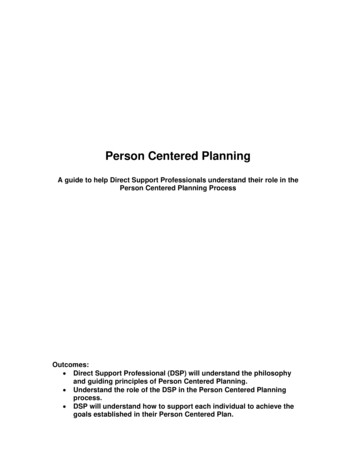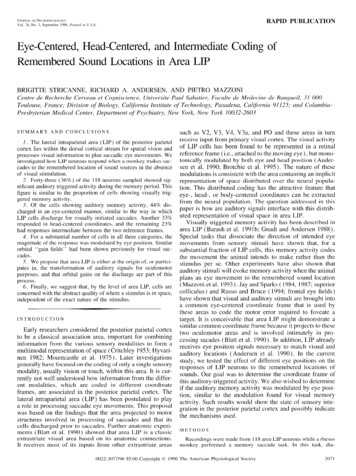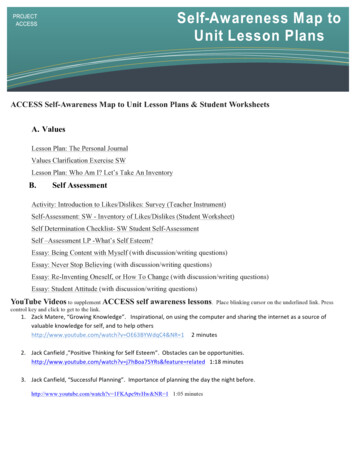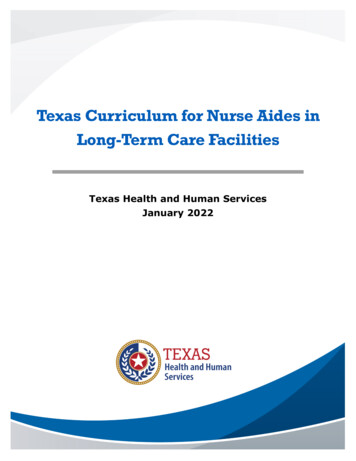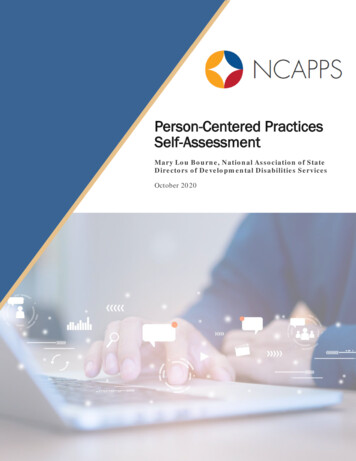
Transcription
Person-Centered PracticesSelf-AssessmentMary Lou Bourne, National Association of StateDirectors of Developmental Disabilities ServicesOctober 2020
IntroductionThis Self-Assessment is designed to help leadership at human service agencies inStates, Tribes, and Territories to measure their progress in developing a more personcentered system. It is designed for use by the administrative entities (“agencies”) withthe authority to administer or operate federal programs for long-term services andsupports, including home and community-based services.It can be used by the wide range of systems that oversee services and supports forpeople with disabilities of all ages, older adults with long-term service and supportneeds, and other health and social service programs.How to Use ItWe encourage you to take this Self-Assessment on a regular basis (for example, everysix months). It should be completed by individuals who have a strong workingknowledge of the operational activities of the system, including the administrativefunctions carried out by the Medicaid authority. Each State, Tribe, or Territory willvary in the use of the Self-Assessment, depending on the breadth of involvement withNCAPPS and other factors. For example, the Self-Assessment may or may not includethe Older Americans act agency, the behavioral health and developmental disabilitiesagencies and/or any other administrative agency overseeing the availability of longterm services and supports. Individuals engaging in the Self-Assessment processshould have the authority to use the information to pursue systems change efforts.If warranted, the Self-Assessment could be filled out by individuals at multiple levelsin the organization (i.e., executives/senior administrators, mid-level managers, andfrontline staff) who can provide diverse insights. If multiple individuals complete theSelf-Assessment, it might be useful to examine average scores as well as measures ofspread (e.g., standard deviation, absolute deviation). Once individuals within theagency have completed the Self-Assessment independently, they can meet to look atthe scores, discuss discrepancies, and come to agreement on a single agency score.The Self-Assessment is divided into eight sections, as shown in the following graphic.Each represents a key area for consideration as agency leadership seeks to increase orexpand person-centered practices.i
Person-Centered Practices Self-Assessment88f J·1-0Elisibility &Service AccessPerson-CenteredCultureLeadershipHow well people in chargeknow about and supportperson-centered practicesHow person -centered is thesystem 's culture and how canperson-centered approacheshelp address risks0S {@%&)0Person-Centered ServicePlanning & MonitoringHow is the process forcreating person-centeredplans and ensuring theservices are workingHow person-centered is theintake and assessmentprocess for people seekingsupports- 0@0Workforce Capacity &CapabilitiesFinanceHow are agreements withproviders structured and howwell are services helpingpeople reach their goalsA8 ·····8V i {@) i8 ,. 88How well staff know aboutand have the skills todeliver person-centeredplanning and supportsL*i. *J.Collaboration &PartnershipQuality&InnovationHow are partnerships withservice users, families, serviceproviders, and advocacyorganizationsThe agency's missionand standardsEach of the eight sections describes observable practice and includes five statementsfrom which to choose. It is very important to read through all of thestatements before checking the one that best applies to your agency. Eachstatement includes bolded key terms to emphasize the most critical change. Choosethe statement in each section that best corresponds with your progress to date. Manyof the statements depict a succession of increasingly person-centered practices. Ifyou’re having a hard time choosing between two statements, check the one thatrepresents practices at your organization that have been fully and completely realized,even if the next statement represents practices that are started or somewhatimplemented. In other words, in order to check the third box, confirm that youragency meets or exceeds the criteria described in the first and second boxes.When first engaging in this assessment, many agencies find the majority of progresstopping out in the first or second statements; this is to be expected and indicates thereis room to grow in your agency. If you are making some progress, you might check thethird statement. Good progress would mean checking the fourth statement, andexcellent progress would mean that you’re checking the fifth statement. It takesii
Person-Centered Practices Self-Assessmentsignificant efforts to move from one statement to the next, and very feworganizations score a four or five in every area.How to Use Your ScoresThe scores from this assessment can inform development of a systems change plan.Examining differences in scores between different programs or staffing levels in youragency might help you identify targeted efforts to support particular areas forimprovement. The plan should describe how you will develop changes to move yoursystem to a score of five (excellent progress). For example, if you score a two in onearea, your action plan will focus on how to move to a three or four. In this way, theSelf-Assessment can help you decide where to focus limited energy and resources. Ifyou complete it on an ongoing basis, the assessment scores can help provide a pictureof whether and how your agency is changing over time as you work toward greaterlevels of person-centered practice. Agency leadership can use the scores tounderstand whether their systems change efforts are effective and provideinformation for changing course if necessary.iii
Person-Centered Practices Self-AssessmentEstablishing Definitions to Help with the SelfAssessmentIt will be helpful for your agency to agree to some basic definitions before youcomplete the Self-Assessment. Senior leadership should identify the following terms:Leadership: What levels of leadership in addition to the highest-level executives areincluded in the definition of leadership for this assessment in your agency?Strategic Plan: What document name is given to the guiding document that setsgoals, initiatives, and strategies to be used by all divisions of the administrativeagency to make decisions and set priorities? Sometimes this is called an annualplanning document, a guiding document, or a strategic plan—or it may be somethingdifferent. Identify the plan used in your agency to which these elements will beapplied.Direct Care Workforce: Who are the staff that would be identified as direct careworkforce in this system? These are not necessarily agency employees; they may workfor private provider agencies. However, in some states that deliver state-operatedservices, there may also be a direct care workforce who are state employees. Thedefinition of direct care workforce here will be used to assess person-centeredpractices in Section 6.3.Advocacy Organizations: Identify groups to include when assessing the agency’sengagement with Advocacy Organizations in Section 7.4.Quality Management or Quality Review Council: What is the name of thecommittee or workgroup to be considered when assessing practices in Section 8.2?This group is typically created or established through the administrative agency and ischarged with reviewing data that demonstrates the service delivery system’sperformance and using such data to identify areas for improvement. Agenciestypically assign such a committee or work group to guide or oversee qualityimprovement strategies for the full system on a regular basis. However, they do notcarry out the tactical operations of quality improvement. This council or committeemight also provide specific guidance to internal quality management offices or otherrelated quality guidance and direction. Some agencies may have a work group orteam focused exclusively on reviewing critical incidents or health/safety data andmaking recommendations on how to improve in this area. While it is a good first step,quality councils typically have a broader charter to include factors beyond health,safety and welfare.iv
The Self-AssessmentLeadership1.1 Leadership 1Our leaders recognize that person-centered planning is important and assign theappropriate authority to program directors to meet basic assurances. 2Our leaders recognize the role person-centered planning plays in establishing values inthe system and assure program directors carry it forward. 3Our leaders value the impact person-centered planning has in people’s lives and onteam effectiveness. We have formal feedback mechanisms to determine how personcentered planning is being implemented. 4Our leaders value the impact of person-centered planning and have been trained inperson-centered planning. Our leaders recognize the applicability of person-centeredprinciples to intake, assessment, planning and monitoring activities (person-centeredpractices). 5Our leaders demonstrate the value of person-centered practices by activelyparticipating in training opportunities, promoting person-centered practices in allfunctional areas within our agency, and consistently communicate the importance ofperson-centered practices. Measures of person-centered practices are part of ourregular quality improvement activities and senior leadership intentionally promotes theuse of person-centered practices with other systems of care including justice,education, healthcare, additional social service agencies.1.2 Strategy 1Our agency does not specifically address person-centered planning or practices in astrategic plan or other key strategy documents. The responsibility for person-centeredplanning and practices lies primarily with service provider agencies or casemanagement agencies, not this agency. 2Our agency has a strategic plan, and our values include the importance of personcentered planning or practices, but we do not have a specific strategy to spreadperson-centered planning and practices. 3We have identified some of the areas of our system that we think will be affected byperson-centered practices and have a clear strategy to address how we will meet theexpectations. We have sought input from other stakeholders on how and whereperson-centered practices can be embedded into our system. 4Our strategy for implementing person-centered practices includes our assessment,planning and monitoring procedures, and training needed to fully understand this newapproach. Our plan includes starting with agency leadership and management stafftraining. 5We have a clear vision and strategy for delivering person-centered practices. Ourstrategy is based on a good understanding of where we are now, and on the futureexpressed by people we support and other stakeholders. Our agency senior leadershipteam actively supports the strategy and has aligned resources to support the strategy.We are all held accountable for delivering on it. Person-centered practices inform allpolicy and guidance materials within our agency.1
1.3 Communication 1We engage with the community using communications practices, but these practicesdo not specifically address person-centered principles and values. 2We understand that for communication practices to be effective, all communications,policy, and practice must be aligned with person-centered principles and values. 3We have begun discussions about a communication strategy that aligns allcommunications, policy, and practice with person-centered principles and values. 4We have designed components of our communication strategy that align allcommunications, policy, and practice with person-centered principles and values. Weare meeting with stakeholders to determine if the strategy ensures the rightcommunication modes to reach all stakeholders, including diverse cultural and ethnicaccessibility. 5Our communication strategy aligns policy and practice with person-centered principlesand values and includes a feedback loop to collect stakeholder input. The strategy alsoincludes various modes of communication that best suit all stakeholders and istransparent, culturally responsive and accessible, and user friendly.1.4 Law/Statute, Regulation, Policy, and Protocols/Guidance 1We have not yet examined statute and regulations for specific areas that address theuse of person-centered planning or practices. 2Our agency recognizes the need to update governance documents to convey ourvalues related to person-centered planning and practices. 3Our agency has identified all regulations and policies that need updating to assureperson-centered planning practices are defined and supported. Our agency has a workplan in place to accomplish the work. 4We have a work team currently updating regulations, policies, and guidancedocuments to assure person-centered planning and practices are defined and clearlydescribed. 5Our policies, regulations, and guidance documents have been updated and fullyimplemented to ensure active promotion of person-centered practices, and thesedocuments are aligned with our statute.2
Person-Centered Culture2.1 Changing the Culture of the Service Delivery System 1Our agency does not actively participate in shaping the culture of person-centeredservice delivery. 2Our agency can influence the culture of our service delivery system, but we do not havea clear plan on how we will do so. 3Our agency has developed a plan, including a communication plan, that describesexpectations of all leaders and managers to engage with service users, familymembers, and service providers. The plan includes a clear set of person-centeredprinciples to guide the practices of all staff across the full agency. 4Our agency identifies areas where person-centered principles and practices havesuccessfully been implemented in their interactions with partners and stakeholders;these stories are shared publicly. 5Our agency staff routinely communicate about person-centered practices in all aspectsof the service delivery system. We demonstrate person-centered principles through theuse of personal narratives and other data during oversight meetings, utilizationreviews, monitoring reviews, trainings, and feedback to all components of the system.2.2 Promoting Cultural Competence through Person-Centered Planning andPractice 1Our agency has a definition of cultural competency that incorporates current bestpractice in understanding cultural, ethnic, linguistic and other differences. 2Our agency applies culturally competent knowledge and expertise in the developmentof person-centered planning procedures. 3Our agency seeks to understand the diverse cultural and linguistic backgrounds of thepeople we serve and those who work in our agencies, and implements training inculturally competent, person-centered practices for all staff members. 4Our agency has incorporated culturally competent practices into all person-centeredtools and procedures and makes this information available to all stakeholders throughtraining, written materials, social media and other means of communicating intendedto reach all types of linguistic needs. 5Person-centered planning tools and practices demonstrate best practice in engagingwith all people we support in culturally competent methods and reflect individualcultural backgrounds and preferences.3
2.3 Person-Centered Approach to Risk 1It is the responsibility of case management and/or providers to address all health andsafety risks in the planning document, and compliance reviews assure this is met. 2Our agency has an assessment and service planning process and procedures thatrequire the team to identify and discuss all risks and how each risk will be mitigated.The policy includes a description of who is on the team and how they are identified. 3Our agency has developed an assessment and service planning process that respectsthe cultural identity of the individual, and includes a discussion of what is important tothe person and associated risks, how the individual prefers to address risk within theirculturally accepted practice, and how the team (including legal guardians asappropriate) will assure a plan is in place to assure preferences are honored while alsominimizing the impact of identified risks. Such assurances include how to resolveconflicts related to risk taking within the context of respecting culturally diverse andappropriate practices. 4Our agency has developed and distributed guidance on how service planning teamswill assess and identify the balance between a person’s desire and rights to takereasonable risks when exploring their community or learning new skills and thepotential harm that may occur. The guidance includes how to develop a riskmanagement plan for these situations, inclusive of supported decision making andconflict resolution procedures for all team members. 5Our agency has worked with all stakeholders—including people who use services,families, service providers, case managers, and others—to develop and implementassessment, service planning, and service plan monitoring procedures that fully alignwith finding a balance between dignity of choice/risk and the supports provided.Included in this are assurances the person has demonstrated an informedunderstanding of the choices made.4
3. Eligibility and Access3.1 Eligibility 1Our agency relies on and uses deficit-based or clinical needs-based assessmentscompleted by professionals to determine eligibility. 2Our agency understands the need to include an interview with the person requestingenrollment along with assessments completed by professionals as part of theeligibility/intake process. The focus of intake and referral is not on potential paidservices but on the goals and outcomes a person wants for their life, respecting theircultural and linguistic background. 3Our agency is in the process of reviewing eligibility requirements to determine how toinclude a person-centered assessment in addition to professionals’ assessments whendetermining eligibility. We are removing discussions of services during intake andeligibility. 4Our agency has developed a new process to determine eligibility that includes aperson-centered assessment developed through conversations with people and theirfamilies or circles of support and clearly demonstrates respect for people’s culturaland/or ethnic background and identity. 5Our agency has implemented the system-wide use of a person-centered assessment inaddition to assessments from health providers to determine eligibility and makeappropriate referrals to additional services, and our agency tracks our results todetermine cultural and ethnic equity in access.3.2 Cultural Relevance and Linguistic Accessibility 1Our agency provides some informational materials in languages other than English butdoes not have a comprehensive plan for ensuring all informational materials areaccessible to people whose proficiency in English language may be limited. 2Our agency uses demographic data to understand the racial, ethnic, and linguisticbackgrounds of people who are eligible for services and uses these data to developlinguistically accessible informational materials. 3Our agency uses demographic data to understand the racial, ethnic, and linguisticbackgrounds of people who seek out services and those determined eligible forservices. We use these data to ensure informational materials are both linguisticallyaccessible and racially, ethnically, and culturally relevant (i.e., pictures and examplesdepict people from different cultural backgrounds, and content is sensitive to culturaldifferences, practices, and customs). 4Our agency partners with members of racially, ethnically, and linguistically diversecommunities and uses demographic data to create culturally and linguisticallyaccessible information distribution methods and materials. 5Our agency uses demographic data and partners with members of culturally andlinguistically diverse communities to develop and execute a strategy forimplementation of entry procedures and distribution of informational materials whichare accessible to people of all cultural, ethnic, and linguistic backgrounds.5
4. Person-Centered Service Planning and Monitoring4.1 Person-Centered Planning and Support Plans 1Our service planning process does not yet require person-centered planningapproaches that meet the requirements found in federal guidance such as thoseoutlined in the federal HCBS regulations § 441.725 and other federal or stateMedicaid HCBS rules, or tribal, territory or other nation regulations (federal and stateHCBS regulations). 2We have identified the need for developing a person-centered planning policy requiringall service plan development to occur through a culturally and linguistically sensitiveperson-centered planning process and meet all statutory or regulatory requirementsfound in federal and state HCBS regulations. 3We are discussing making changes to our service planning process so that all plansare developed through a culturally and linguistically sensitive person-centered planningprocess and meet the requirements in federal and state HCBS regulations. Discussionsinclude how to address what is important to the person and what is important for theperson within the cultural and ethnic communities present in our service system. 4We are revising our service plan policy to include a requirement that all plans must bedeveloped through a culturally and linguistically informed person-centered planningprocess and meet the requirements in federal and state HCBS regulations. Theprocess includes identifying strategies for the person to lead their own planning ifdesired, resolving disagreements, addressing what is important to the person and whatis important for the person, and how the team will identify and plan for any known risksthe individual may encounter when learning or engaging in new experiences. Ourrevisions include assuring the documents and procedures incorporate support for thediverse cultural and linguistic traditions, values, and backgrounds present in ourcommunities. 5Our service planning process is in alignment with all applicable federal and state HCBSregulations. The process includes identifying strategies for the person to lead their ownplanning if desired, resolving disagreements, addressing what is important to theperson and what is important for the person, respecting the individual’s unique culturalor ethnic traditions, values, and background, and how the team will identify and planfor any known risks the individual may encounter when learning or engaging in newexperiences.6
4.2 Monitoring 1Our case management monitoring process does not require service plans to addressthe preferences of the person, or that the plan include data collection strategies fordemonstrating the effectiveness of any modifications to a person’s rights. 2Our agency has identified the need to develop a plan describing how we will redesignthe case management monitoring process to include routine review of service plansthat ensure preferences are included in addition to the needs of the person, and thatservice plans that call for modification to a person’s rights also include a datacollection strategy to demonstrate effectiveness of the modification(s). 3Our plan for updating the case management monitoring policy includes a method toconsult with and directly involve stakeholders from all cultural and ethnic backgroundsin our communities, in developing a streamlined case management monitoring processthat includes routine review of service plans that ensure preferences are included inaddition to the needs of the person, reasonable risks will be accepted and addressed,and that service plans that call for modification to a person’s rights also include a datacollection strategy to demonstrate effectiveness of the modification(s). 4Our state has initiated implementation of a new case management agency monitoringprocess that ensures service plans demonstrate respect for the unique cultural identityof the person, address the needs and preferences of the person, supports areimplemented as identified and authorized, reasonable risk is accepted and includessteps for mitigation, and any modifications to a person’s rights are identified andinclude data collection reviews to test the effectiveness of the modification(s), or weare working on streamlining our current approach. 5Currently our case management monitoring process ensures service plansdemonstrate respect for the unique cultural identity of the person, address the needsand preferences of the person, supports are implemented as identified and authorized,risk is accepted and includes steps for mitigation, and any modifications to a person’srights are identified and include data collection reviews to test the effectiveness of themodification(s).7
Finances5.1 Contracting 1Our agency currently holds contracts that are generally focused on meeting compliancerequirements and reporting on compliance activities. 2Our agency understands that our contracts should include requirements for personcentered planning, person-centered training for case management/providers, providingperson-centered services, and reporting on these requirements. 3Our agency is engaged in discussion about methods for embedding person-centeredprinciples into all contract and reporting requirements. 4Our agency is revising contracts to include requirements for person-centered planningfor all people receiving services, training in person-centered principles for all staff, andrequirements for performance measures and reporting standards related to personcentered requirements. 5Our agency contracts require person-centered planning for all people receivingservices, training in person-centered principles for all staff, and requirements forperformance measures and reporting standards related to person-centeredrequirements. We also require performance improvement activities for unacceptableperformance with contract requirements.5.2 Authorizing Services 1Service plans are developed within the program’s required frequency cycle (e.g.,annually, twice per year) with a specific set of services authorized. Amendments toservice authorizations are very cumbersome and take significant time to accomplish. 2We understand that people’s needs are dynamic, and the service planning process andservice authorizations must align with a person’s changing needs. 3We are discussing how to ensure the service authorization process is dynamic,responsive, flexible, and that it supports accomplishing personal outcomes for peopleusing services. 4We are implementing policy that requires service authorizations to align with goals oroutcomes and to be dynamic, responsive, and flexible with clear timeframes. 5Our system requires that service planning demonstrate person-centered values (i.e.,dynamic, responsive, and flexible). Our service planning and authorization process alsoensures that services are designed around personal goals and objectives, can changeas needed, do not hold a person back from taking new opportunities, and areaccomplished in a timely fashion.8
6. Workforce Capacity and Capabilities6.1 Case Managers/Service Coordinators 1Our agency has case management expectations that include knowledge of serviceplanning and monitoring, but the expectations do not specify person-centeredpractices. 2Our agency has begun identifying the person-centered assessment, planning, andmonitoring expectations, and we have identified the knowledge and skills needed forcase managers. 3Our agency has clearly identified the knowledge and skills needed for case managersto complete person-centered assessments, planning, and monitoring, includingsupervisory expectations for mentoring. 4Our agency is building the training curriculum that is needed to ensure case managershave the right knowledge and skills to complete person-centered assessments,planning, and monitoring, which includes making an investment in supervisors toensure adequate mentoring. 5Our agency ensures case managers can continue to demonstrate knowledge ofculturally, ethnically, and linguistically informed person-centered assessment,planning, and monitoring. We ensure that case managers can maintain that knowledgeby receiving support and mentoring from their supervisors and attending ongoingtraining sessions.6.2 Agency Employees 1All agency staff have knowledge of person-centered planning, including administrativestaff (financial and support) and all senior and executive leadership. 2All agency staff have been trained in the fundamentals of person-centered practices,including person-centered assessment, planning, and monitoring procedures andrequirements including knowledge and awareness of cultural and ethnic communities,as appropriate. 3All agency staff, including senior and executive leaders, can demonstrate the linksbetween our mission and vision and person-centered practices. Our clinical staffroutinely align culturally and linguistically sensitive person-centered assessment,planning, and monitoring tools with clinical expectations of the field. 4All agency staff annually attend training to update their knowledge and apply newknowledge and understanding to existing procedures when engaging withstakeholders, to assure understanding and respect for cultural and linguisticdifferences. 5All agency staff have opportunities to utilize person-centered practices during hiring,onboarding, and annual performance reviews, and person-centered discovery tools areused to identify learning outcomes for each employee.9
6.3 Supporting Direct Care Workforce 1Direct care workforce stability is the responsibility of provider agencies; our agencystaff are not or cannot be involved in private provider staffing decisions. 2Our agency has identified areas in which direct care workforce stability impacts thesuccessful im
1.3 Communication 1 We engage with the community using communications practices, but these practices . do not specifically address person-centered principles and values. 2 We understand that for communication practices to be effective, all communications, policy, and practice mus
